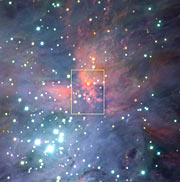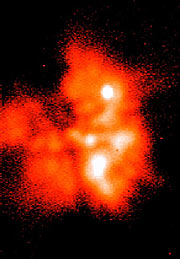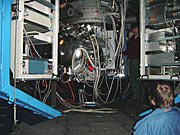Comunicato Stampa
TIMMI2 Images the Heart of the Orion Nebula
New Vistas with Powerful Thermal Infrared Instrument at La Silla
30 Marzo 2001
A new astronomical instrument, TIMMI2, has just been installed on the ESO 3.6-metre telescope at La Silla. The first images have just been obtained and hold great promise for future research programmes with this facility. The Thermal Infrared MultiMode Instrument was built in a collaboration between ESO and a consortium headed by the Jena University Observatory (Germany). It detects infrared radiation in the 5-24 µm mid-IR spectral region. It is particularly well suited for observations of the complex processes that take place in the innermost regions of star-forming clouds. It is also a forerunner of a similar, but even more powerful instrument to be installed at the 8.2-metre VLT telescopes on Paranal during the next years. Among the first images are some of the most penetrating, mid-infrared views ever obtained of the central region of the Orion Nebula.
Mid-infrared TIMMI2 images of a starforming region in Orion
A group of astronomers [1] has recently imaged a star-forming region in the Orion Nebula with a new and powerful astronomical instrument, the Thermal Infrared MultiMode Instrument (TIMMI2), now available at the La Silla Observatory. In addition to being scientifically very interesting, these observations also provide a demonstration of the impressive capabilities of this new facility.
It has been known for some time that the "BN/KL Complex" is a site of recent, massive star formation. It is located deep inside the Orion Nebula (ESO Press Photo eso0113a) and is observed as a cluster of infrared-emitting objects and compact regions of ionized Hydrogen ("H II regions"), associated with intricate interstellar dust filaments and circumstellar dust clouds. There are also several hot and large stars in this heavily obscured area - together they shine as bright as 100,000 suns.
It is a difficult task to identify the main sources of heating in this region - the "heart" of the Orion BN/KL star-forming complex . For this, a combination of sharp images (at 1 arcsec resolution or better) at different wavelengths is required. This is now possible with ISAAC near-infrared and TIMMI2 mid-infrared images that together show the energy distribution of the individual sources.
The present TIMMI2 images of the BN/KL Complex were obtained at two different wavelengths, 10.3 µm (ESO Press Photo eso0113b) and 20.0 µm (ESO Press Photo eso0113c).
These mid-infrared photos are powerful tools for the astronomers' attempts to analyze the very early processes of star formation. They mainly show the thermal radiation from the dust in the area that is heated by the UV and visible light from the stars, and especially the comparatively warm, dense dust cocoons around the very young stars. Contrarily, the slightly older stars in this area have already blown away most of their dust shell and can therefore be seen at shorter wavelengths, e.g. in the ISAAC image (ESO Press Photo eso0113a), but not in the TIMMI2 photos.
The dust clouds through which we can now look with TIMMI2 are extremely dense. The obscuration in the visual region of the spectrum is enormous, about 60 magnitudes (i.e., a factor of 10 24). No wonder that even the largest telescopes cannot get through to those "hidden" objects in visual light!
The ratio between the TIMMI2 images ("20µm/10µm"; ESO Press Photo eso0113d) provides a temperature map of the dust in this region. The "hottest" (brightest in this photo) areas mostly correspond to the cocoons around the very young stars. With the excellent image sharpness (about 1 arcsec) provided by TIMMI2, it was possible to identify ten new mid-infrared sources on this photo. From the image ratio, dust temperatures of up to about 190 °C (460K) are measured.
The TIMMI2 instrument
The new Thermal Infrared MultiMode Instrument (TIMMI2) (ESO Press Photo eso0113e) is a second-generation instrument for the ESO 3.6-m telescope on La Silla [2]. It is the most sensitive and most versatile instrument of its kind available in the world and puts European astronomy at the forefront of research in this field.
TIMMI2 is a combined camera and spectrometer that is able to register radiation ("light") in the mid-infrared spectral range from 5-24 µm. It is the successor to the most productive TIMMI instrument that was used at La Silla and decommissioned in 1998, cf. e.g., the reports about the first observations of structures in the disk around the star Beta Pictoris pointing to the presence of planets (article in Nature 369, p.628; 1994), the impact of Comet SL-9 on Jupiter and also about Comet Hale-Bopp.
To achieve sufficient sensitivity for thermal radiation from celestial objects, TIMMI2 must be cooled (as a normal camera for visible light must be black inside and light-tight). It operates at -230°C and the detector is kept at -260°C.
Mid-infrared astronomy is a very promising field
Quite apart from its own capabilities, TIMMI2 also represents an important step towards the VLT Mid Infrared Spectrometer/Imager VISIR, a similar, but even more advanced mid-infrared instrument for ESO's Very Large Telescope at Paranal. VISIR is now being constructed under ESO contract at research institutes in France and the Netherlands. It is planned to install it on the 8.2-m MELIPAL in 2002. The sensitivity will be five times higher than that of TIMMI2 and it will produce images that are twice as sharp. Until then, the ESO astronomers and engineers as well as many visiting astronomers will have gained invaluable experience with TIMMI2, ensuring them a fast and efficient entry into this largely unexplored field of astronomy.
Mid-infrared observations like these are a most valuable tool for studying the birth of stars and the formation of circumstellar disks and planets. As such it is complementary to submm observations, e.g. with the future ALMA facility.
Later, an extremely large telescope with similar instrumentation - like the 100-m OWL for which a concept study is now underway at ESO - may be used to image earth-size planets orbiting stars in our cosmic neighbourhood.
Note
[1] The team consists of Rolf Chini and Markus Nielbock (Astronomisches Institut, Ruhr-Universität Bochum, Germany), Ralf Siebenmorgen and Hans-Ulrich Käufl (ESO-Garching, Germany).
[2] A more exhaustive description of TIMMI2 is available in the ESO Messenger (No. 102, page 4).
Contatti
Ralf Siebenmorgen
ESO
Garching, Germany
Tel.: +49-89-3200-6598
E-mail: rsiebenm@eso.org
Sul Comunicato Stampa
| Comunicato Stampa N": | eso0113 |
| Legacy ID: | Photo 12a-e/01 |
| Nome: | Becklin/Neugebauer Complex, BN/KL Complex, M 42, Messier 42, Orion Nebula |
| Tipo: | Milky Way : Nebula : Type : Star Formation |
| Facility: | ESO 3.6-metre telescope, Very Large Telescope |
| Instruments: | ISAAC, TIMMI2 |
Our use of Cookies
We use cookies that are essential for accessing our websites and using our services. We also use cookies to analyse, measure and improve our websites’ performance, to enable content sharing via social media and to display media content hosted on third-party platforms.
ESO Cookies Policy
The European Organisation for Astronomical Research in the Southern Hemisphere (ESO) is the pre-eminent intergovernmental science and technology organisation in astronomy. It carries out an ambitious programme focused on the design, construction and operation of powerful ground-based observing facilities for astronomy.
This Cookies Policy is intended to provide clarity by outlining the cookies used on the ESO public websites, their functions, the options you have for controlling them, and the ways you can contact us for additional details.
What are cookies?
Cookies are small pieces of data stored on your device by websites you visit. They serve various purposes, such as remembering login credentials and preferences and enhance your browsing experience.
Categories of cookies we use
Essential cookies (always active): These cookies are strictly necessary for the proper functioning of our website. Without these cookies, the website cannot operate correctly, and certain services, such as logging in or accessing secure areas, may not be available; because they are essential for the website’s operation, they cannot be disabled.
Functional Cookies: These cookies enhance your browsing experience by enabling additional features and personalization, such as remembering your preferences and settings. While not strictly necessary for the website to function, they improve usability and convenience; these cookies are only placed if you provide your consent.
Analytics cookies: These cookies collect information about how visitors interact with our website, such as which pages are visited most often and how users navigate the site. This data helps us improve website performance, optimize content, and enhance the user experience; these cookies are only placed if you provide your consent. We use the following analytics cookies.
Matomo Cookies:
This website uses Matomo (formerly Piwik), an open source software which enables the statistical analysis of website visits. Matomo uses cookies (text files) which are saved on your computer and which allow us to analyze how you use our website. The website user information generated by the cookies will only be saved on the servers of our IT Department. We use this information to analyze www.eso.org visits and to prepare reports on website activities. These data will not be disclosed to third parties.
On behalf of ESO, Matomo will use this information for the purpose of evaluating your use of the website, compiling reports on website activity and providing other services relating to website activity and internet usage.
Matomo cookies settings:
Additional Third-party cookies on ESO websites: some of our pages display content from external providers, e.g. YouTube.
Such third-party services are outside of ESO control and may, at any time, change their terms of service, use of cookies, etc.
YouTube: Some videos on the ESO website are embedded from ESO’s official YouTube channel. We have enabled YouTube’s privacy-enhanced mode, meaning that no cookies are set unless the user actively clicks on the video to play it. Additionally, in this mode, YouTube does not store any personally identifiable cookie data for embedded video playbacks. For more details, please refer to YouTube’s embedding videos information page.
Cookies can also be classified based on the following elements.
Regarding the domain, there are:
- First-party cookies, set by the website you are currently visiting. They are stored by the same domain that you are browsing and are used to enhance your experience on that site;
- Third-party cookies, set by a domain other than the one you are currently visiting.
As for their duration, cookies can be:
- Browser-session cookies, which are deleted when the user closes the browser;
- Stored cookies, which stay on the user's device for a predetermined period of time.
How to manage cookies
Cookie settings: You can modify your cookie choices for the ESO webpages at any time by clicking on the link Cookie settings at the bottom of any page.
In your browser: If you wish to delete cookies or instruct your browser to delete or block cookies by default, please visit the help pages of your browser:
Please be aware that if you delete or decline cookies, certain functionalities of our website may be not be available and your browsing experience may be affected.
You can set most browsers to prevent any cookies being placed on your device, but you may then have to manually adjust some preferences every time you visit a site/page. And some services and functionalities may not work properly at all (e.g. profile logging-in, shop check out).
Updates to the ESO Cookies Policy
The ESO Cookies Policy may be subject to future updates, which will be made available on this page.
Additional information
For any queries related to cookies, please contact: pdprATesoDOTorg.
As ESO public webpages are managed by our Department of Communication, your questions will be dealt with the support of the said Department.





